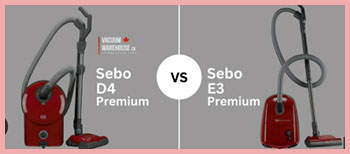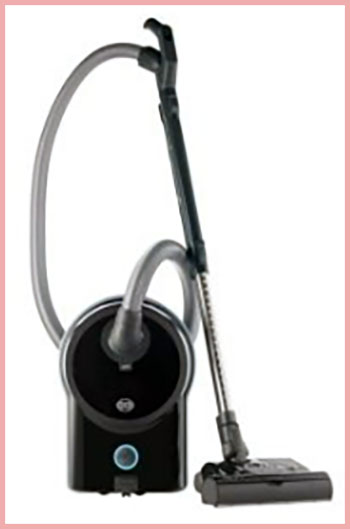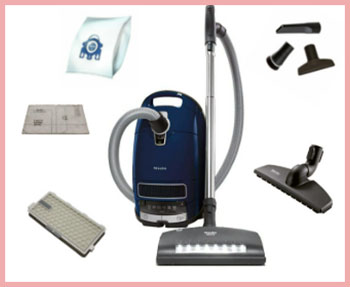I’ve spent years navigating the world of vacuum cleaners, from budget models that barely last a season to high-end machines that promise a spotless home. When it came to choosing a premium canister vacuum for my own space, I narrowed it down to two German powerhouses: the SEBO Airbelt D4 Premium and the Miele Complete C3. My goal with this article is to share my hands-on experience, breaking down their key features, pros, and cons to help you decide which vacuum suits your needs.
Let’s get started with a side-by-side comparison to set the stage.
Comparison Table: SEBO Airbelt D4 vs. Miele Complete C3
| Feature | SEBO Airbelt D4 Premium | Miele Complete C3 (Various Models) |
| Weight | 15.9 lbs | 11.9–28.2 lbs (varies by model) |
| Suction Power | ~1200W (est. 200 AW) | 1200W (est. 200 AW) |
| Dustbag Capacity | 1.5 gallons (4.5L) | 2.5L |
| Cleaning Radius | 52 ft | 29–36 ft |
| Filtration | S-Class (HEPA optional) | AirClean (HEPA optional) |
| Cord Length | 40 ft | 24–29.5 ft |
| Powerhead | ET-1 (4 height settings) | SEB 228/236 (5 height settings) |
| Noise Level | ~79 dB | ~74–77 dB |
| Warranty | 5 years | 7 years (varies by model) |
| Price (Approx.) | $899–$999 | $799–$1,499 |
My Journey with Vacuums: Why SEBO and Miele?
I’ve owned my fair share of vacuums—some were loud, clunky beasts that left dust clouds in their wake. Others were sleek but underpowered gadgets that couldn’t handle pet hair.

After moving into a home with a mix of hardwood, tile, and plush carpets, I knew I needed something robust yet versatile. SEBO and Miele kept popping up in my research, praised for their German engineering, durability, and stellar performance. Both brands have a cult following among allergy sufferers, pet owners, and clean freaks like me, so I decided to put the SEBO Airbelt D4 Premium and the Miele Complete C3 head-to-head.
Unpacking the SEBO Airbelt D4 Premium
The SEBO Airbelt D4 feels like a tank—solid, reliable, and built to last. Weighing in at 15.9 pounds, it’s not the lightest, but it’s manageable for most. The first thing I noticed was its massive 52-foot cleaning radius, thanks to a 40-foot cord and a flexible hose. I could vacuum my entire living room and hallway without unplugging, which was a game-changer compared to my old corded models.
Key Features of the SEBO Airbelt D4

The D4’s ET-1 powerhead is a standout. With four height settings, it adapts to everything from low-pile rugs to thick carpets.
I tested it on my shag rug, and it glided smoothly, picking up dog hair without tangling. The variable suction control, adjustable via a slider on the hose handle, let me dial down the power for delicate curtains and crank it up for deep-cleaning carpets.
The 1.5-gallon dustbag is another win—spacious enough to last months in my medium-sized home, reducing the hassle of frequent changes.
The S-Class filtration system (with an optional HEPA upgrade) is a boon for allergy sufferers. I noticed cleaner air while vacuuming, and the sealed design ensured no dust escaped.
The Airbelt bumper, a soft strip around the canister, protected my furniture from scratches, which I appreciated while navigating tight corners. The LED suction indicator was a nice touch, letting me know I was always at optimal power.
Pros of the SEBO Airbelt D4
- Massive Cleaning Range: That 52-foot radius meant fewer outlet switches, saving me time and effort.
- Low Maintenance Costs: Larger dustbags and longer-lasting filters (about $20 for a four-pack of bags) keep recurring costs down.
- Durable Design: Built like a commercial-grade machine, it’s backed by a 5-year warranty.
- Superior Edge Cleaning: The ET-1 powerhead’s design excels at cleaning along baseboards without needing the hose.
- Allergen Control: The S-Class filtration traps 99.9% of particles, and the optional HEPA filter is a lifesaver for sensitive noses.
Cons of the SEBO Airbelt D4
- Weight: At 15.9 pounds, it’s heavier than some Miele models, which I felt when lugging it upstairs.
- Single Motor System: Unlike some Miele models with dual motors, the D4 relies on one motor for suction and brush agitation, which can feel less aggressive on thick carpets.
- Basic Controls: The suction control on the hose handle is a simple +/- switch, which I found less intuitive than Miele’s pictogram settings.
- Bulky Appearance: It’s not the sleekest vacuum, which might bother those who prioritize aesthetics.
Exploring the Miele Complete C3
The Miele Complete C3 lineup is like a choose-your-own-adventure book, with models like the Alize, Cat & Dog, Marin, and Brilliant catering to different needs. I tested the C3 HomeCare+ PowerLine, which comes with the SEB 228 powerhead and a 1200W motor. At 11.9 pounds for the lighter models, it’s noticeably easier to maneuver than the SEBO, especially in tight spaces like my cluttered guest room.
Key Features of the Miele Complete C3
The C3’s 1200W motor delivers suction power comparable to the SEBO, estimated at around 200 air watts. Its SEB 228 or 236 powerhead (depending on the model) offers five height settings, giving me more control over carpet types. I loved the foot-operated controls for suction and cord rewind—no bending over required. The AirClean filtration system, with an optional HEPA upgrade, kept my air fresh, and the onboard tool storage (dusting brush, upholstery tool, crevice nozzle) was convenient for quick switches.
The C3’s 2.5L dustbag is smaller than the SEBO’s, but I found it sufficient for a week of heavy cleaning. The 29–36-foot cleaning radius, while shorter than the SEBO’s, was still practical for most rooms. The quieter operation (around 74–77 dB) was a pleasant surprise, letting me vacuum without waking my napping dog.
Pros of the Miele Complete C3

- Lightweight and Maneuverable: Models like the Alize are as light as 11.9 pounds, making them easier to carry and navigate.
- Quiet Operation: At 74–77 dB, it’s less disruptive, ideal for homes with kids or pets.
- Versatile Attachments: The VarioClip and onboard storage make switching tools a breeze.
- Advanced Controls: Six suction settings with pictograms and foot controls are user-friendly and precise.
- Premium Build: The high-grade plastic body and stainless steel wand feel luxurious and durable.
Cons of the Miele Complete C3
- Higher Maintenance Costs: Smaller 2.5L bags and pricier filters (about $44.99) add up over time.
- Shorter Cleaning Radius: The 29–36-foot range requires more outlet changes in larger spaces.
- Complex Repairs: The sophisticated design means repairs often require an authorized service center, which can be inconvenient.
- Edge Cleaning: The C3 struggles with edge cleaning unless you use the hose, unlike the SEBO’s powerhead.
Head-to-Head: Performance on Different Surfaces
I put both vacuums through their paces on my home’s mix of hardwood, tile, low-pile rugs, and plush carpets. Here’s how they stacked up.
Hardwood and Tile
On hardwood and tile, both vacuums shone. The SEBO’s Parquet tool with removable bristles handled larger debris like cereal crumbs without pushing them around. This was a problem I’ve had with lesser vacuums.
The Miele’s Pure Suction Parquet Floorhead was equally effective, gliding smoothly and picking up dust and pet hair effortlessly. The Miele’s lighter weight made it easier to maneuver around furniture, but the SEBO’s longer cord meant I could cover my entire kitchen without unplugging. For bare floors, it’s a tie, with the Miele edging out slightly for maneuverability.
Low-Pile Rugs and Carpets
On low-pile rugs, the SEBO’s ET-1 powerhead excelled, its four height settings adapting well to my area rugs. It sucked up embedded dirt and pet hair with ease, and the variable suction let me fine-tune for delicate fabrics.
The Miele’s SEB 228 powerhead, with five height settings, offered a bit more precision, and its automatic suction adjustment (on models like the Marin) was a nice touch for seamless transitions. The Miele’s quieter operation was a bonus here, but the SEBO’s larger dustbag meant fewer interruptions. I’d give a slight edge to the Miele for its refined control.
Plush Carpets
Thick carpets were a tougher test. The SEBO’s single motor struggled slightly on my plush bedroom carpet, requiring multiple passes to lift deep dirt. The Miele’s dual-motor system (on models like the Cat & Dog) gave it an advantage, agitating and sucking up debris more aggressively.
However, the SEBO’s powerhead was easier to clean when hair tangled, as it pops out with a twist. The Miele’s powerhead, while effective, required more effort to maintain. For plush carpets, the Miele takes the lead, especially for pet owners.
Edge and Stair Cleaning
Edge cleaning was a clear win for the SEBO. Its ET-1 powerhead hugged baseboards, picking up dust and crumbs without needing the hose. The Miele required detaching the hose for edges, which was less convenient.
For stairs, the Miele’s lighter weight and compact design made it easier to carry and maneuver, but its shorter hose was limiting. The SEBO’s longer hose and cord were more practical for stairs, though its weight was a drawback. If stairs are a priority, the Miele’s portability wins; for edges, the SEBO dominates.
Filtration and Allergen Control
As someone with mild allergies, filtration was a big deal for me. The SEBO’s S-Class filtration system captures 99.9% of particles down to 0.3 microns, and the optional HEPA filter pushes it to 99.97%. I noticed no dust clouds or sneezing fits while vacuuming, and the sealed design ensured clean exhaust.
The Miele’s AirClean system is equally impressive, with a HEPA option that matches the SEBO’s allergen-trapping prowess. Both are excellent for allergy sufferers, but the SEBO’s larger dustbag and lower filter costs give it a slight edge for long-term use.
Maintenance and Cost of Ownership
Owning a premium vacuum isn’t just about the upfront cost—it’s about the long game. The SEBO’s 1.5-gallon dustbags last longer and cost less (around $20 for four) compared to the Miele’s 2.5L bags (about $20 for four, but smaller capacity means more frequent changes). SEBO filters are also cheaper and last longer, and the simple design makes DIY repairs like cord fixes a breeze. The Miele’s complex build often requires professional servicing, which can add up. For example, replacing a Miele powerhead flap can be pricey and requires a service center visit.
Initial costs vary: the SEBO D4 ranges from $899 to $999, while the Miele C3 spans $799 for the Calima to $1,499 for the Brilliant. The Miele’s longer 7-year warranty (on some models) offers peace of mind, but the SEBO’s lower maintenance costs make it more economical over time. If budget is a concern, the SEBO is the smarter investment.
Design and User Experience
The SEBO’s design is functional but not flashy. Its bulky canister and industrial look might not win beauty contests, but the ergonomic hose and Airbelt bumper make it practical. I loved the rotating suction hose for navigating corners, and the onboard tools (dusting brush, upholstery tool, crevice nozzle) were always within reach.
The Miele, by contrast, feels like a luxury car—sleek, quiet, and intuitive. The foot controls and pictogram suction settings were a joy to use, and the stainless steel wand added a premium touch. For aesthetics and ease of use, the Miele feels more refined, but the SEBO’s simplicity has its own charm.
Durability and Warranty
Both brands are built to last, with users reporting 20+ years of service from proper maintenance. The SEBO’s straightforward design makes it easier to service at home, and its 5-year warranty covers motor and non-wear parts. The Miele’s 7-year warranty (on models like the HomeCare+) is longer, but its complex design can make repairs trickier. I felt confident in both vacuums’ longevity, but the Miele’s warranty edge is appealing for those who value extra coverage.
My Verdict: Which Should You Choose?
After weeks of testing, I found both the SEBO Airbelt D4 and Miele Complete C3 to be exceptional, but they cater to slightly different needs. If you have a large home, prioritize low maintenance costs, and need superior edge cleaning, the SEBO D4 is your best bet. Its massive cleaning radius, large dustbag, and durable design make it a workhorse for big spaces and allergy sufferers. However, if you value portability, quiet operation, and refined controls, the Miele C3 is the way to go, especially for smaller homes or mixed flooring.
For me, the Miele C3 edged out slightly because its lighter weight and quieter operation fit my multi-level home and noise-sensitive dog. But I can’t deny the SEBO’s cost-effectiveness and range make it a close contender. Your choice depends on your priorities—large spaces and budget favor the SEBO; portability and polish favor the Miele.
Frequently Asked Questions (FAQ)
Neither is objectively better—it depends on your needs. SEBO excels in cleaning range, edge performance, and lower maintenance costs, while Miele offers lighter weight, quieter operation, and more refined controls. Both are top-tier for durability and allergen control.
Absolutely, it offers powerful suction, excellent filtration, and versatile attachments, making it a top choice for allergies and mixed flooring.
No, the Miele C3 is not discontinued as of 2025. It remains a flagship model with various configurations like the Alize, Marin, and Brilliant.
SEBO vacuums are praised for their durable German engineering, powerful suction, large dustbags, and excellent filtration (S-Class or HEPA). Their long cleaning radius and low maintenance costs make them a favorite for large homes and professionals.
The Dyson Vis NAV’s suction power isn’t explicitly stated in air watts, but Dyson’s robot vacuums typically range around 65–75 AW, less than the 200 AW estimated for the SEBO D4 and Miele C3. It’s designed for convenience rather than raw power.
Read More: Miele vs. Roomba
Conclusion
You’re now armed with the insights to choose between the SEBO Airbelt D4 and Miele Complete C3. Both are exceptional, but your decision hinges on what matters most: the SEBO’s long reach and cost savings or the Miele’s portability and polished experience. I’ve shared my journey to help you navigate this choice, and I’m confident either vacuum will elevate your cleaning game. Weigh your home’s size, flooring, and budget, and you’ll find the perfect fit for a cleaner, healthier space.
